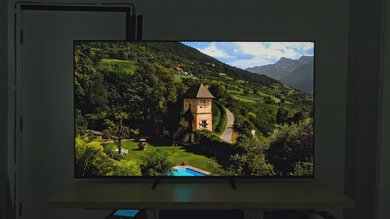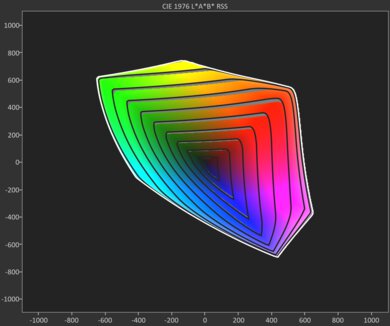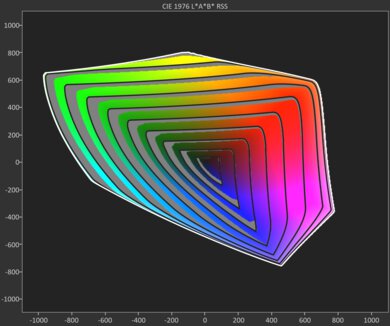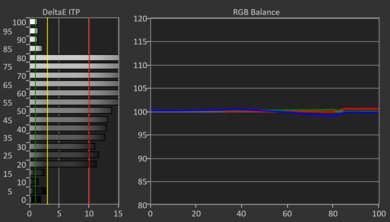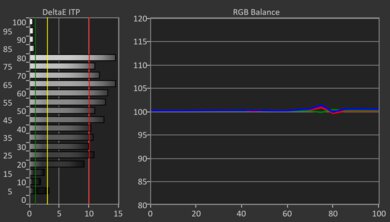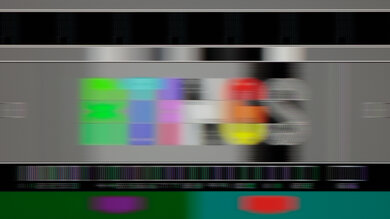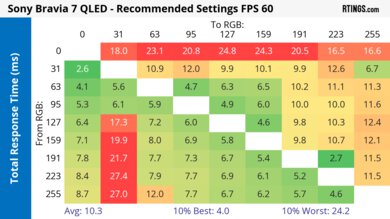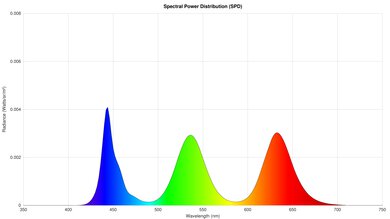The Sony BRAVIA 7 QLED is a premium TV released in 2024. Featuring a Mini LED backlight, it sits below the Sony BRAVIA 8 OLED and the Sony BRAVIA 9 QLED and above the entry-level Sony BRAVIA 3. It's Sony's cheapest TV released in 2024 to feature local dimming. Like all recent high-end Sony TVs, it offers a wide range of features, including an ATSC 3.0 (NEXTGEN TV) tuner, hands-free voice control, and the latest in gaming features. It runs the Google TV 12 smart interface, which has an easy-to-use, premium interface and a ton of apps available to download. It's powered by Sony's XR image processor and the MediaTek Pentonic 1000 chipset, and it's available in 55, 65, 75, and 85-inch sizes. We bought and tested the 65-inch size.
Our Verdict
The Sony BRAVIA 7 is impressive for mixed usage. The TV excels most in reference conditions due to its very good black levels, wide range of vibrant colors, and image processing. However, it also looks great with the lights on since it doesn't lose much image quality from ambient lighting and has the SDR brightness needed to overcome glare from indirect light sources. However, it's best to avoid placing the TV screen in front of direct light sources, since its direct reflection handling is inadequate. HDR content is impactful thanks to its excellent HDR brightness, which is great for movies, shows, and games. Speaking of games, the TV has the modern gaming features needed to take advantage of your Series X|S or PS5, although fast motion is blurry. The biggest downside of the TV is that it has a narrow viewing angle, so it's not a good option for a wide seating arrangement.
Very good black levels with minimal blooming.
Excellent HDR brightness for highlights that really stand out.
Superb SDR brightness helps it overcome glare from indirect lighting.
Fantastic upscaling and great low-quality content smoothing.
Colors are vibrant, lifelike, bright, and accurate.
Inadequate handling of direct reflections.
Slow pixel transitions in Game Mode leads to blurry motion.
The Sony BRAVIA 7 is great for a home theater. It displays very deep blacks with only some minor blooming around subtitles and some highlights. Additionally, the TV displays vibrant and accurate colors with minimal banding, and it displays HDR content very close to the intended brightness level, so this is a TV that respects the filmmaker's intent. This TV also has excellent HDR brightness, so highlights really pop out in bright HDR content. If you watch SD content or low-bitrate streams, the TV's fantastic upscaling and great low-quality content smoothing means you don't have to look at a soft and noisy image. Unfortunately, its stutter performance is mediocre due to its relatively fast response time, so you will see some stutter during slow camera pans if you're sensitive to it.
Very good black levels with minimal blooming.
Excellent HDR brightness for highlights that really stand out.
Fantastic upscaling and great low-quality content smoothing.
Colors are vibrant, lifelike, bright, and accurate.
Outstanding PQ EOTF tracking means HDR content has accurate brightness.
Noticeable stutter during slow camera movements.
The Sony BRAVIA 7 is great overall for a bright room. However, its direct reflection handling is inadequate, so it's best to avoid placing the TV opposite a window or lamp if you don't want to be distracted by reflections. Outside of that, the TV performs well due to its superb SDR brightness that helps it overcome glare from indirect lighting. In addition to that, you still enjoy great picture quality since its blacks remain deep and colors remain well-saturated in a bright room.
Superb SDR brightness helps it overcome glare from indirect lighting.
Colors are vibrant, lifelike, bright, and accurate.
Inadequate handling of direct reflections.
The Sony BRAVIA 7 is great for watching sports. Due to its superb SDR brightness, it easily overcomes glare from indirect light sources. However, reflections from direct light sources like a window opposite the screen are very visible and distracting. Colors are nice and vibrant on this model, and they're accurate, too, so the color of teams' jerseys is true to life. The TV has fantastic upscaling and does a great job cleaning up artifacts in low-bitrate content; since most sports are in SD and are broadcast or streamed in a heavily compressed manner, this top-notch image processing goes a long way. Although you do see some dirty screen effect when watching sports with large areas of uniformity, it's not too bad, and not everyone will be bothered by this. Unfortunately, your friends will be bothered by the TV's image quality if they're sitting to the sides of the screen since it has a narrow viewing angle. Thankfully, motion in sports is smooth thanks to its fairly quick response time.
Superb SDR brightness helps it overcome glare from indirect lighting.
Fantastic upscaling and great low-quality content smoothing.
Colors are vibrant, lifelike, bright, and accurate.
Inadequate handling of direct reflections.
Some noticeable dirty screen effect towards the center of the screen.
The Sony BRAVIA 7 is good for gaming. It displays very deep blacks with minimal blooming around highlights, as well as bright and vibrant colors, so its overall image quality is great. Furthermore, highlights in HDR games are very impactful due to the TV's excellent HDR brightness. It has HDMI 2.1 bandwidth on two of its ports for up to 4k @ 120Hz gaming with VRR. Unfortunately, the TV's pixel transitions are disappointing, so fast motion in games has noticeable trails of blur behind it. Although the TV's input lag is low enough for a responsive feel, it's higher than competing models from other brands, which isn't ideal for competitive gamers.
Excellent HDR brightness for highlights that really stand out.
HDMI 2.1 bandwidth, up to 4k @ 120Hz, and VRR support.
Colors are vibrant, lifelike, bright, and accurate.
Higher input lag than competing models.
Only supports 4k @ 120Hz on two ports.
Slow pixel transitions in Game Mode leads to blurry motion.
The Sony BRAVIA 7 has amazing brightness capabilities. Its SDR brightness is superb, so you can crank up the luminance in a bright room to overcome glare. The TV also has excellent HDR brightness, leading to highlights that truly pop out.
Excellent HDR brightness for highlights that really stand out.
Superb SDR brightness helps it overcome glare from indirect lighting.
The Sony BRAVIA 7 has very good black levels. Its local dimming feature is very effective, so you get deep and uniform blacks, with only some minor blooming around subtitles and some highlights.
Very good black levels with minimal blooming.
The Sony BRAVIA 7 has impressive colors. Its SDR color volume is very good, which leads to a vibrant image, and its accuracy is excellent in SDR, so colors stay true to the filmmaker's intent. The TV's HDR color volume is excellent, so colors in HDR content are vivid, lifelike, and bright. Its HDR pre-calibration accuracy is good, so most viewers will be satisfied, but enthusiasts will likely want to get the TV calibrated for the best accuracy in HDR.
Colors are vibrant, lifelike, bright, and accurate.
Note: We're in the process of improving our tests related to image processing, but this score should give you a general idea of how a TV performs overall with its image processing capabilities.
The Sony BRAVIA 7 has excellent image processing. It does a fantastic job upscaling, so SD and HD content don't lack sharpness. It also does a great job smoothing out artifacts in heavily compressed content, so you don't have to look at an image that's full of artifacts. The TV has outstanding PQ EOTF tracking, so the HDR content isn't too dark or too bright. There's some visible banding in bright green gradients, but all other colors have very minimal or no banding at all, so gradients are mostly smooth.
Fantastic upscaling and great low-quality content smoothing.
Outstanding PQ EOTF tracking means HDR content has accurate brightness.
Very little banding in color gradients.
The Sony BRAVIA 7 has just okay responsiveness in Game Mode. It has HDMI 2.1 bandwidth for up to 4k @ 120Hz with VRR, so you can game in up to 120 fps with almost no screen-tearing, which is great. However, it has very slow pixel transitions, so fast motion has noticeable blur behind it. Its input lag is low enough for a responsive feel, but it's higher than similar models from other brands, so competitive gamers looking for the lowest input lag possible will want to look elsewhere.
HDMI 2.1 bandwidth, up to 4k @ 120Hz, and VRR support.
Higher input lag than competing models.
Only supports 4k @ 120Hz on two ports.
Slow pixel transitions in Game Mode leads to blurry motion.
We're in the process of fixing the way we evaluate a TV's overall motion handling. This section is currently broken, and the score isn't indicative of how well a TV handles motion overall.
Performance Usages
Changelog
-
Updated Nov 05, 2025:
Mentioned the newly reviewed Sony BRAVIA 5 98 in the Style section.
-
Updated Jun 12, 2025:
Mentioned the newly reviewed Sony BRAVIA 5 in the Upscaling section.
- Updated May 08, 2025: Converted to Test Bench 2.0.1. We did this to fix an issue with our scoring in the Supported Resolutions section, since TVs with a refresh rate higher than 144Hz were being penalized for not supporting 144Hz.
-
Updated May 02, 2025:
We mentioned the newly reviewed Samsung QN90F in the Input Lag section of this review.
Check Price
Differences Between Sizes And Variants
We bought and tested the 65-inch Sony BRAVIA 7, but it's also available in 55-inch, 75-inch, and 85-inch sizes in other regions, and most of these results are also valid for those sizes. The number of local dimming zones varies between sizes, so the contrast and dark room performance, in general, are slightly different depending on which size you get. Sony doesn't provide zone counts for different sizes, so we don't know how different they are. Costco has a 65-inch and a 75-inch variant of the TV with different model codes. These variants perform the same, but they come with an extended warranty, an extended trial for the Sony Pictures Core streaming service, and a backlit remote.
| Size | Model Number | Local Dimming Zones | Costco Variant |
|---|---|---|---|
| 55" | K-55XR70 | Unknown | - |
| 65" | K-65XR70 | 480 | K65XR70CB |
| 75" | K-75XR70 | 720 | K75XR70CB |
| 85" | K-85XR70 | Unknown | - |
Our unit was manufactured in April 2024.
Popular TV Comparisons
The Sony BRAVIA 7 QLED is a bit of an odd TV. It delivers truly impressive picture quality with Sony's top-tier image processing, sitting between the 2023 Sony X93L and the Sony X95L, but Sony has made some strange choices on this model. Its narrow viewing angle and disappointing reflection handling limit its versatility, as it's not suitable for all room setups. If you're mainly in a dark room and these things don't matter to you, it's a great choice. If you're looking for something that's more affordable, you can get similar picture quality from TVs like the Hisense U8/U8N and the TCL QM8/QM851G QLED, albeit with worse image processing overall.
See our recommendations for the best TVs for watching movies, the best smart TVs, and the best 65-inch TVs.
The TCL QM8K is a bit better than the Sony BRAVIA 7 for the most part. The TCL is brighter, with better contrast and more uniform blacks, so low-light scenes look better, and HDR stands out better. The TCL is also the better gaming TV thanks to its Game Accelerator feature, which offers a higher refresh rate when paired with a resolution lower than 4k. The Sony, on the other hand, has better processing, so it does a better job scaling and cleaning up low-resolution or low-quality content streams.
The LG C5 OLED delivers a better overall experience than the Sony BRAVIA 7. The LG TV looks better in a dark room, as its nearly infinite contrast ratio delivers a punchier image in HDR. Even though the Sony is technically brighter, HDR is more impactful on the LG. The LG is also better for gaming thanks to its nearly instantaneous response time, which results in crystal-clear motion and no blur around fast-moving objects.
The Sony BRAVIA 9 is better than the Sony BRAVIA 7. The BRAVIA 9 has better SDR brightness and much better reflection handling, so it overcomes more glare in a bright room. Highlights stand out more in HDR content on the BRAVIA 9 due to its better HDR brightness, and it has a better local dimming feature that provides better contrast for deeper blacks with less blooming. The BRAVIA 9 has a mediocre viewing angle, but the image holds up better from the sides of the screen than it does on the BRAVIA 7, so it's a bit better for watching TV with a group. Finally, the BRAVIA 9 has a faster response time for a bit less blur behind quick motion.
The Sony BRAVIA 7 offers superior picture quality over the Sony BRAVIA 5. The BRAVIA 7 has superior contrast with less blooming, is a lot brighter in SDR and HDR, and has the advantage when it comes to color vibrancy and accuracy. These attributes mean the TV has noticeably better picture quality with all content.

We buy and test dozens of TVs yearly, taking an objective, data-driven approach to deliver results you can trust. Our testing process is complex, with hundreds of individual tests that take over a week to complete. Most of our tests are done with specially designed test patterns that mimic real content, but we also use the same sources you have at home to ensure our results match the real-world experience. We use two main tools for our testing: a Colorimetry Research CR-100 colorimeter and a CR-250 spectroradiometer.
Test Results

The peak brightness in HDR is excellent. It's bright enough to bring out the brightest highlights and flashes of light in most HDR content.
These measurements are after calibrating the HDR white point with the following settings:
- HDR Picture Mode: Professional
- Brightness: Max
- Contrast: 90
- Color Temperature: Expert 2
- HDR Tone Mapping: Gradation Preferred
- Peak Luminance: High
- Auto Local Dimming: High
Switching to the low-latency Game Mode results in slightly brighter small highlights, but it's barely noticeable.
These measurements are after calibrating the HDR white point with the following settings:
- HDR Picture Mode: Game
- Brightness: Max
- Contrast: 90
- Color Temperature: Expert 2
- HDR Tone Mapping: Gradation Preferred
- Peak Luminance: High
- Auto Local Dimming: High
The peak brightness in SDR is superb. There's some variation in brightness with different content, but it's not noticeable with most content. This is a TV that overcomes glare from indirect lighting with ease.
These measurements are after calibration with the following settings:
- Picture Mode: Professional
- Brightness: Max
- Contrast: 90
- Color Temperature: Expert 1
- Peak Luminance: High
- Auto Local Dimming: High
The Sony BRAVIA 7 has very good contrast thanks to its Mini LED backlight. The native contrast with local dimming disabled is decent, but bumping Auto Local Dimming to 'High' delivers the best results overall, with deep blacks and very bright highlights.
There's some noticeable blooming around bright highlights, but it's very good overall. It's especially noticeable around subtitles or bright lights in fairly dark scenes. Note that the larger sizes have more local dimming zones, so they likely have even better local dimming performance, with less blooming than the 55- and 65-inch models.
The local dimming zone transitions are good overall, but there are a few distracting issues. There's no flicker, which is great, but there's a noticeable halo effect as bright objects move across the screen. The halo effect gets worse the quicker objects move, as the local dimming can't quite keep up with it.
After firmware 112.626.140.1, there's pretty much no difference in local dimming performance, as seen in this video comparison. On the top left is the old result in the Professional Mode, and on the top right is the old result in Game Mode. The bottom left is with the new firmware in the Professional Mode, and on the bottom right is the new result in Game Mode.
The Sony BRAVIA 7’s SDR color volume is very good overall. It has excellent coverage of the DCI-P3 color space, with consistent coverage across the board. Its coverage of the wider BT.2020 color space is more limited, but it's still decent overall, and it does well with very light colors.
| Volume ΔE³ | DCI-P3 Coverage |
BT.2020 Coverage |
|---|---|---|
| L10 | 92.15% | 69.36% |
| L20 | 93.20% | 71.07% |
| L30 | 92.88% | 71.07% |
| L40 | 92.53% | 72.55% |
| L50 | 92.19% | 72.92% |
| L60 | 91.59% | 72.54% |
| L70 | 91.62% | 70.85% |
| L80 | 91.28% | 68.21% |
| L90 | 90.90% | 67.92% |
| L100 | 91.85% | 84.46% |
| Total | 91.82% | 71.28% |
The TV's HDR color volume is excellent. Colors are bright and vibrant, and dark tones are displayed well, thanks to the high contrast ratio.
With just a few quick settings changes out of the box, this TV has excellent SDR accuracy. The overall white balance is great, and its color temperature is nearly perfect. Gamma in SDR is slightly above the target, so bright scenes are a bit crushed. Color accuracy is amazing, with no noticeable issues outside of minor errors in whites.
The calibration system on this TV is extremely effective and easy to use. Although it already has excellent accuracy out of the box, it's even better after calibrating it, and there are no noticeable issues after.
See our full settings used for calibration.
The Sony BRAVIA 7 TV has good HDR pre-calibration accuracy. Its white balance is decent overall, but there's either too much or not enough blue, red, and green in most shades of gray. However, its color temperature is incredibly close to 6500K. Colors have okay accuracy, but there are errors throughout, and reds are undersaturated.
HDR accuracy is very good after calibration. White balance is very good now, but there's still a bit too much blue and red in most shades of gray. Color temperature is still incredibly close to 6500K. Colors are more accurate now, but they're not perfect, and there are still some mapping errors throughout.
As is typical for Sony TVs, the Sony BRAVIA 7 has outstanding PQ EOTF tracking. Blacks aren't quite true black, but other than that, it's nearly perfect. There's a slow roll-off for content mastered up to 4000 nits, which helps to maintain detail in highlights that are brighter than the TV's capabilities.
Similar to low-quality content smoothing, this TV also upscales low-resolution content well. Fine details in low-resolution content like DVDs are preserved well.
These results are with the following processing settings:
- Sharpness: 60
- Reality Creation: Auto
If you want a Sony TV, but you can't afford this model, the Sony BRAVIA 5 offers the same upscaling performance.
The gradient handling on this TV is impressive overall. There's some noticeable banding in brighter shades of green and very slight banding in everything else, but it's not very noticeable.
This TV has low input lag when in Game Mode, ensuring a smooth and responsive gaming experience. It's higher than competing models from most other brands, but still low enough for non-competitive gamers. If you'd prefer a TV with lower input lag, check out the Samsung QN90F instead.
The Sony BRAVIA 7 supports most common resolutions, up to 4k @ 120Hz with HDMI ports 3 and 4. Chroma 4:4:4 and RGB signals are displayed properly with 1080p and 4k signals, which is essential for clear text when using it as a PC monitor. HDMI ports 1 and 2 are limited to HDMI 2.0 bandwidth and don't support 4k @ 120Hz inputs.
The Sony BRAVIA 7 supports variable refresh rate technology to reduce screen tearing. HDMI Forum VRR and G-SYNC compatibility work over the entire refresh rate range, but it doesn't support FreeSync.
The Sony BRAVIA 7 has disappointing pixel transitions at its maximum refresh rate of 120Hz. Its response time is very slow in Game Mode, so fast motion is blurry. However, there's no overshoot, so you don't see inverse ghosting.
The Sony BRAVIA 7 has disappointing pixel transitions at its maximum refresh rate of 120Hz. Its response time is very slow in Game Mode, so fast motion is blurry. However, there's no overshoot, so you don't see inverse ghosting.
It has disappointing pixel transitions at 60Hz. There's a lot more overshoot at 60Hz, which leads to inverse ghosting. There's also persistence blur due to the nature of a slower 60Hz refresh rate. Combined with the TV's lackluster pixel transitions, motion in 60Hz games is quite blurry.
With the exception of 1440p, the TV is fully compatible with everything the PS5 offers, like 4k @ 120Hz, as well as HDMI Forum VRR. It also supports Auto Low Latency Mode, so you don't have to manually switch to Game Mode to get the lowest input lag.
With the exception of 1440p, the TV is fully compatible with everything the Xbox Series X|S offers, including 4k @ 120Hz, HDMI Forum VRR, FreeSync Premium Pro, and Dolby Vision gaming. It also supports Auto Low Latency Mode, so you don't have to manually switch to Game Mode to get the lowest input lag.
Due to the TV's quick response time, there's some minor stutter when watching movies or TV shows, and it's most apparent in slow panning shots. However, not everyone will notice this.
This TV removes judder automatically from 24p sources, like a Blu-ray player or an external streaming device with a 'Match Frame Rate' feature. For 60Hz sources, like a cable box or the native apps, Motionflow has to be enabled, with both sliders at 'Min' and CineMotion set to 'High' to remove judder.
The Sony BRAVIA 7 uses pulse width modulation (PWM) to control the backlight intensity. It flickers at 720Hz in all picture modes, which is high enough that it isn't noticeable, but it can still bother those sensitive to flicker.
With local dimming disabled, the TV is flicker-free at backlight settings between 15 and 50.
There's an optional backlight strobing feature, commonly known as black frame insertion, which you can enable to improve the appearance of motion. It works at both 60Hz and 120Hz.
The Sony BRAVIA 7 has inadequate direct reflection handling. Direct light sources like a lamp or window opposite your screen are very noticeable since the TV barely reduces the intensity of those reflections.
There's only some minor black level raise in a room with ambient lighting, so you still get deep blacks with your lights turned on.
The TV's perceived color volume in a bright room is great. Colors barely lose any saturation when the TV is exposed to light, so you can still enjoy punchy colors in a well-lit room.
Unfortunately, one of the biggest downsides of the Sony BRAVIA 7 is its viewing angle, which is significantly worse than that of both the Sony X93L and the Sony X95L, as it lacks Sony's 'X-Wide Angle' technology. Only the step-up Sony BRAVIA 9 QLED has that feature in 2024. This TV is unsuitable for a wide seating arrangement, as anyone sitting off-center will see a faded, washed-out image.
The gray uniformity on this TV is decent. There are a few darker splotches across the screen, a bit of vignetting in the corners, and some minor dirty screen effect towards the center of the screen, but most of these minor issues aren't noticeable with most content.
This TV uses a BGR subpixel layout. It doesn't affect picture quality but can cause blurry text in some applications when using it as a PC monitor.
The TV has great separation between colors, which helps with its color purity and its ability to display a wide range of colors.
HDMI ports 3 and 4 support the full 48Gbps bandwidth of HDMI 2.1, while HDMI 1 and 2 are limited to HDMI 2.0 bandwidth. However, because HDMI 3 is an HDMI 2.1 and eARC port, you lose an HDMI 2.1 slot if you connect a soundbar.
This TV supports eARC, which allows you to pass high-quality, uncompressed audio to a compatible receiver through an HDMI cable. It supports all major audio formats, so you don't have to worry about compatibility with external sources.
The Sony K65XR70 has a sleek, premium design that looks great in any room. It has thin bezels on three sides, with a slightly thicker bottom bezel that has a brushed metallic finish.
If you want a massive Sony TV, you need to step down to the Sony BRAVIA 5 98.
The slim metal feet hold the TV very well, and there are four mounting options depending on your needs. The feet can be set in either a wide or narrow position depending on your cabinet, and both options offer a low or high setting, so you can place a soundbar in front of the screen without blocking it.
Footprint of the 65-inch stand in the narrow, low position as shown: 18.8" x 13.6" x 1.7". The wide position increases the stand's width to 47.8 inches, and setting it to the high position increases the height between the table and the screen to 3.8 inches, so almost all soundbars fit in front of the screen without blocking the image.
The back of the TV has a nice, clean look, with the typical checkerboard pattern found on all other recent Sony TVs. Sadly, there's nothing for cable management, so it's hard to get the clean look you could achieve with other recent Sony TVs, like the Sony X93L/X93CL.
Unfortunately, like most TVs, the interface contains ads. You can opt out of personalized ads, but this doesn't change the number of ads you'll see; they just won't be personalized to match your search and viewing history.
Even though it's significantly brighter than the Sony X93L, it draws roughly the same amount of power. Sony has considerably improved their power efficiency without sacrificing picture quality or brightness.
The Sony BRAVIA 7 has a decent frequency response. There's very little bass, which is normal with modern TVs, so the low-frequency extension is quite high. Above the LFE, the frequency response is well-balanced at moderate volume levels, but it's a bit worse at max volume. Speaking of, the TV can't get very loud, and there's noticeable compression and pumping at max volume.






